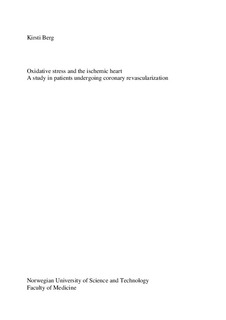| dc.contributor.author | Berg, Kirsti | nb_NO |
| dc.date.accessioned | 2014-12-19T14:23:25Z | |
| dc.date.available | 2014-12-19T14:23:25Z | |
| dc.date.created | 2006-07-06 | nb_NO |
| dc.date.issued | 2004 | nb_NO |
| dc.identifier | 125110 | nb_NO |
| dc.identifier.isbn | 82-471-7291-7 | nb_NO |
| dc.identifier.uri | http://hdl.handle.net/11250/264642 | |
| dc.description.abstract | The isoprostane 8-iso-PGF2α proved to be a valuable marker of conditions associated with oxidative stress in all three clinical studies (I-III). Somewhat surprising, no significant correlation with myocardial reperfusion events was found. Only the duration of severe ischemia correlated positively in patients with AMI undergoing primary PCI (II). Thus the first aim of this thesis was partly fulfilled. A particular finding was that other conditions than myocardial ischemia-reperfusion such as interventional (I) and surgical (III) traumas contributed to an apparent oxidative stress in the patient groups. In parallel, pro- or antioxidant drug effects seemed to have influenced the release pattern of 8-iso-PGF2α, underlining the versatility of this parameter of lipid peroxidation.
The second aim of the thesis, to establish a relationship between oxidative stress and myocardial injury, was not fulfilled. Thus the present studies I-III seem to refute the hypothesis of a major ROS-involvement in myocardial ischemia-reperfusion injuries as shown in animal experiments. Another interpretation is that an oxidation-injury relationship was masked in the more complex pathophysiology of a clinical setting. A further implication may be that 8-iso-PGF2α behaved as a passive indicator of successful reperfusion rather than as an active indicator of severe and injury-inducing oxidative stress, reflecting the role as a ROS-imprint and not as an injury marker.
The third aim of the thesis, to try out potent antioxidants on a rational basis, did not materialize as the studies went on. However, in the course of time new mechanisms of cardioactive or adjunctive drugs were recognized. Thus both ASA and heparin are two candidates which may have had a major impact on the results in all three studies. Concerning ASA both positive effects of an acute booster dose (II) and negative effects of withdrawal (III) warrant further attention.
Although the study is limited by the low numbers of patients, it seems justified to suggest that the lack of success in translating principles of oxidative stress and antioxidant therapy from the experimental to the clinical stage of myocardial ischemia-reperfusion may now have found a more plausible explanation than hitherto proposed. Thus oxidative stress, if present, is a multifactorial process with complex interactions between pro- and antioxidant factors and with largely unrecognized protection by drugs in common use. | nb_NO |
| dc.language | eng | nb_NO |
| dc.publisher | Det medisinske fakultet | nb_NO |
| dc.relation.ispartofseries | Doktoravhandlinger ved NTNU, 1503-8181; 2005:198 | nb_NO |
| dc.relation.haspart | Berg, Kirsti; Wiseth, Rune; Bjerve, Kristian; Brurok, Heidi; Gunnes, Sigurd; Skarra, Sissel; Jynge, Per; Basu, Samar. Oxidative Stress and Myocardial Damage during Elective Percutaneous Coronary Interventions and Coronary Angiography. Free Radical Research. 38(5): 517-525, 2004. | nb_NO |
| dc.relation.haspart | Berg, Kirsti; Jynge, Per; Bjerve, Kristian; Skarra, Sissel; Basu, Samar; Wiseth, Rune. Oxidative stress and inflammatory response during and following coronary interventions for acute myocardial infarction. Free Radical Research. 39(6): 629-636, 2005. | nb_NO |
| dc.title | Oxidative stress and the ischemic heart: A study in patients undergoing coronary revascularization | nb_NO |
| dc.type | Doctoral thesis | nb_NO |
| dc.contributor.department | Norges teknisk-naturvitenskapelige universitet, Det medisinske fakultet, Institutt for sirkulasjon og bildediagnostikk | nb_NO |
